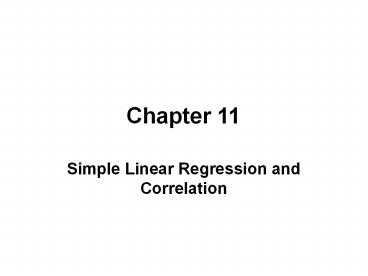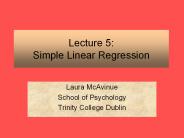Simple Linear Regression and Correlation - PowerPoint PPT Presentation
Title:
Simple Linear Regression and Correlation
Description:
Chapter 11 Simple Linear Regression and Correlation Learning Objectives Use simple linear regression for building empirical models Estimate the parameters in a linear ... – PowerPoint PPT presentation
Number of Views:129
Avg rating:3.0/5.0
Title: Simple Linear Regression and Correlation
1
Chapter 11
- Simple Linear Regression and Correlation
2
Learning Objectives
- Use simple linear regression for building
empirical models - Estimate the parameters in a linear regression
model - Determine if the regression model is an adequate
fit to the data - Test statistical hypotheses and construct
confidence intervals - Prediction of a future observation
- Use simple transformations to achieve a linear
regression model - understand the correlation
3
Regression analysis
- Relationships between two or more variables
- Useful for these types of problems
- Predict a new observation
- Sometimes a regression model will arise from a
theoretical relationship - At other times no theoretical knowledge
- Choice of the model is based on inspection of a
scatter diagram - Empirical model
4
Regression Model
- Mean of the random variable Y is related to x
- EYx?Yx?0 ?1x
- ?0 and ?1 called regression coefficients
- Appropriate way to generalize this to a
probabilistic model - Assume that the expected value of Y is a linear
function of x - Actual value of Y is determined by the mean value
function plus a random error term - Y?0 ?1x?
- Where ? called random error term
5
?1 and ?
- Suppose that the mean and variance of ? are 0
and ?2 - Slope, ?1, can be interpreted as the change in
the mean of Y - Height of the line at any value of x is just the
expected value of Y for that x - Variability of Y at a particular value of x is
determined by the error variance ?2 - Implies that there is a distribution of Y-values
at each x
6
Graph of the Variability
Y
- Distribution of Y for any given value of x
- Values of x are fixed, and Y is a random variable
with the following mean and variance - Mean ?Yx?0 ?1x
- Variance ?2
True regression line
x
7
Simple Linear Regression
- Values of the intercept, slope and the error
variance will not be known - Must be estimated from sample data
- Fitted model is used in prediction of future
observations of Y at a particular level of x
8
Method of Least Squares
- True relationship between Y and x is a straight
line - Assume n pairs of observations
- Estimates of ?0 and ?1 result in a line that is a
best fit to the data - Called method of least squares
9
Least Squares Method
- Assuming the n observations in the sample
- Sum of the squares of the deviations of the
observations from the true regression line - Taking the partial derivatives
10
Least Squares Method-Cont.
- Simplifying
- Results are
- Fitted or estimated regression line is
11
Using Special Symbols
- Convenient to use special symbols
- Numerator
- Denominator
12
Residual Error
- Describes the error in the fit of the model to
the ith observation yi - Each pair of observations satisfies
- Denoted by ei
13
Estimating ?2
- Another unknown parameter,?2, the variance of the
error term ? - Residuals ei are used to obtain an estimate of ?2
- Sum of squares of the residuals, often called the
error sum of squares - A more convenient computing formula
- SST is the total sum of squares
14
Example
- Regression methods were used to analyze the data
from a study investigating the relationship
between roadway surface temperature (x) and
pavement deflection ( y). - Summary quantities were as follows
15
Questions
- (a) Calculate the least squares estimates of the
slope and intercept. Graph the regression line. - (b) Use the equation of the fitted line to
predict what pavement deflection would be
observed when the surface temperature is 85F. - (c) What is the mean pavement deflection when the
surface temperature is 90F? - (d) What change in mean pavement deflection would
be expected for a 1F change in surface
temperature?
16
Solution
- Need to have
- Hence, the slope and intercept
- Regression line
17
Solution-Cont.
- Graph of the regression line
18
Solution-Cont.
- Pavement deflection
- Mean pavement deflection
- Change in mean pavement deflection
19
Properties of the Least Estimators
- Assumed that the error term ? in the model is a
random variable - Estimators will be viewed as random variables
- Properties of the slope
- Properties of the intercept
20
Analysis of Variance Approach
- Used to test for significance of regression
- Partitions the total variability in the response
variable into two components - First term is called error sum of squares
- Second term is called regression sum of squares
- Symbolically
- SSTSSRSSE
- SST is the total corrected sum of squares
21
Analysis of Variance
- SST, SSR, and SSE has n-1, 1, and n-2 d.o.f,
respectively - SSR ß1Sxy and SSESST- ß1Sxy
- Divide by its d.o.f
- MSRSSR/1 and MSESSE/n-2
- Then FMSR/MSE follows F1,n-2 distribution
22
Hypothesis Tests for Slope
- Adequacy of a linear regression model
- Appropriate hypotheses for slope are
- H0 ß1ß1,0
- H1 ß1ß1,0
- Test Statistic
- Follows the F 1,n-2 distribution
- Reject H0 if f0gtf?,1,n-2
23
Analysis of Variance for Testing Significance of
Regression
24
Example
- Consider the data from the previous example on
xroadway surface temperature and ypavement
deflection. - (a) Test for significance of regression using a
- 0.05. What conclusions can you draw?
- (b) Estimate the standard errors of the slope and
intercept.
25
Solution
- Use the steps in hypotheses testing
- 1) Parameter of interest is slope of the
regression line ?1 - 2)
- 3)
- 4) ? 0.05
- 5) The test statistic is
- 6) Reject H0 if f0 gt f?,1,18 where f0.05,1,18
4.416
26
Solution
- 7) Using the results from the previous example
- Hence, the test statistic
- 8) Since 73.95 gt 4.416, reject H0 and conclude
the model specifies a useful relationship at ?
0.05 - Standard error
27
Confidence Intervals on the Slope and Intercept
- Interested to obtain C.I. estimates of the
parameters - Width of these C.I. is a measure of the overall
quality of the regression line - 100(1-a) C.I. on the slope ß1
- 100(1-a) C.I. on the intercept ß0
28
Confidence Interval on the Mean Response
- Constructed on the mean response at a specified
value of x, say, x0 - Called a C.I. about the regression line
- C.I. about the mean response at the value of xx0
- Applies only to the interval
29
Prediction of New Observations
- An important application of a regression model
- New observation is independent of the
observations used to develop the regression model - C.I. for ?Yx is inappropriate
- Prediction interval on a future observation at
the value x0 - Always wider than the C.I. at x0
- Depends on both the error from the fitted model
and the error associated with future observations
30
Example
- The first example presented data on roadway
surface temperature x and pavement deflection y - Find a 99 confidence interval on each of the
following - (a) Slope
- (b) Intercept
- (c) Mean deflection when temperature x85o F
- (d) Find a 99 prediction interval on pavement
deflection when the temperature is 90oF.
31
Solution
- a) Confidence interval on the slope
- Critical value
- t?/2,n-2 t0.005,18 2.878
- Hence
- b) Confidence interval on the intercept
32
Solution
- c) 99 confidence interval on ? when x85 F
- d) 99 prediction interval when x90 F.
33
Residual Analysis
- Helpful in checking the errors are approximately
normally distributed with constant variance - Useful in determining whether additional terms in
the model are required - Construct normal probability plot of residuals
- Patterns of residual plots
34
Coefficient of Determination(R2)
- Judge the adequacy of a regression model
- Coefficient of determination
- Referred as the amount of variability in the data
explained by the regression model and - SSR is that portion of SST that is explained by
the use of the regression model - SSE is that portion of SST that is not explained
by the use of the regression model
35
Transformation of Data Points
- Inappropriateness of straight-line regression
model - Scatter diagram
- Consider the exponential function
- Yß0eß1x? transformed to a straight line
- By a logarithmic transformation
- ln Ylnß0 ß1 x ln ?
- Another intrinsically linear function is
Yß0ß1(1/x)? - By using the reciprocal transformation z1/x
- Yß0 ß1 z ?
- Transformed error terms ? are normally distributed
36
Correlation
- Assumed that x is a mathematical variable and
that Y is a random variable - Many applications involve situations in which
both X and Y are random variables - Suppose observations are jointly distributed
random variables - Measures the strength of linear association
between two variables and denoted by ? - Shows how closely the points in a scatter diagram
are spread around the regression line
37
Hypothesis Tests
- Useful to test the hypotheses
- H0 ?0
- H1 ?0
- Appropriate test statistic
- Follows the t distribution with n-2 degrees of
freedom - Reject the null hypothesis if
38
Next Agenda
- Chapters 13 deals with designing and conducting
engineering experiments - ANOVA in designing single factor experiments will
be emphasized































